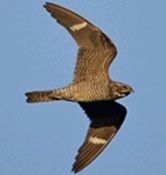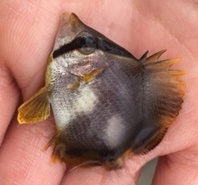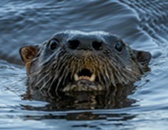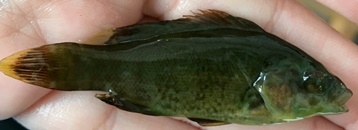Hudson River Almanac 8/16/18 - 8/24/18
The New York State Department of Environmental Conservation sent this bulletin on 08/31/2018 02:05 PM EDT |
| DEC Delivers - Information to keep you connected and informed from the NYS Department of Environmental Conservation |
| Share or view as a web page || Update preferences or unsubscribe |
|
Compiled by Tom Lake, Hudson River Estuary Program Consulting NaturalistOverviewThe occurrence of two uncommon-to-rare fishes highlighted the week sharing the spotlight with the ongoing late-summer migration of the common nighthawks. Highlight of the Week8/19 – Brooklyn, New York City: We had spotted a school of banded rudderfish in the East River on a previous visit and were now determined to catch one. This would be only the third record in the Hudson estuary that we knew of. Using rod and reel, we fished off Pier 5 using frozen spearing (Atlantic silverside) and caught seven ranging in size from 200-240 millimeters (mm). We also caught summer flounder and bluefish. The water temperature was 76 degrees Fahrenheit (F) and the salinity, at 18.0 parts-per-thousand (ppt.), was a bit more than half seawater. [Banded rudderfish (Seriola zonata) are a member of a tropical-looking family of fishes called the jacks (Carangidae). Other jacks that occasionally appear in the Hudson include crevalle jack, Atlantic moonfish, permit, lookdown, and the round scad. These are temperate-water marine strays and are typically young-of-year, late-summer, and early-autumn visitors to the lower, brackish estuary. Tom Lake] [The banded rudderfish was added to our watershed fish list in August 2014 after a school showed up at The River Project on Pier 40 in Manhattan. A second banded rudderfish was caught at Pier 46 in August 2016. If you would like an electronic copy (e-mailed as an attachment) of the Hudson River Fish Fauna Checklist, please e-mail me: trlake7@aol.com.] [Note: one inch = 25.4 millimeters (mm)] Natural History Entries8/16 – Hudson River: The data for the seventh annual Great Hudson River Estuary Fish Count (8/10-8/11), featuring 14 sites from the Mohawk River to New York City, was finally compiled. Our total of 2,782 fish counted included a record number of species (55). Croton Point had the most species with 15, while Kingston Point had the highest number of total individual fish for the day with 344. The most abundant species this year was Atlantic silverside, followed by young-of-year blueback herring and striped bass. One new species was collected, the northern puffer at Fort Totten Park in Queens. Across seven years, we have recorded 60 species of fish as well as many invertebrates such as blue crabs and moon jellyfish. 8/16 – Sleepy Hollow, HRM 28: We watched an osprey winging its way over the river toward us with a small fish in its talons. The bird suddenly swerved upriver, which seemed puzzling, until an adult bald eagle swooped into the picture and chased the osprey toward Scarborough. We never got to see how that chase concluded. [“Pirates” on the river! One of the best shows, often in late-summer or fall, is watching eagles watch osprey. While eagles are among the best hunters of fish, they frequently allow osprey to do the heavy lifting, then swoop down and steal their catch. - Tom Lake] 8/17 – Esopus Meadows, HRM 87: There were at least eight black terns at Esopus Meadows tonight in the pouring rain, followed by a beautiful rainbow. 8/17 – West Haverstraw, HRM 38.5: Arriving at work this morning, I counted 17 black vultures gathered near a dumpster. They were feasting on, and fighting over, cat food regularly left there by someone hoping to help feral cats. Another pair of vultures sat ominously above the portico and didn’t move a feather as I walked beneath them (shiver!). 8/17 – Manhattan, HRM 1: We checked our research sampling gear in Hudson River Park at The River Project's sampling station on the lighthouse tender Lilac at Pier 25, and found nine young-of-year oyster toadfish, all between 20-38 mm in length. [The River Project maintains licensed collection gear – crab pots and killifish traps – in the river off Pier 25. The equipment serves two purposes: to collect aquatic life for their aquaria and education programs at Pier 40, and to document daily change in the community of life off the west side of Manhattan. Tom Lake]
[The eastern box turtle (Terrapene c. carolina) has unusual protection in New York State. Since 1905, the turtle has been listed as a “game species”, but with no open season. Tom Lake] 8/19 – Rensselaer County, HRM 172: We saw four migrating common nighthawks flying south this evening while walking Burgess Road in East Hoosick. 8/19 – Clinton Corners, HRM 82: Rolling our umbrella down in preparation for a line of thunderstorms, my wife was startled when she saw a little brown bat (Myotis lucifugus) resting in an umbrella on our deck. The bat flew away quickly. Later, when I put it back up, the amazing little bat came back to the umbrella. 8/19 – Ulster County, HRM 78: I spotted a beautiful hummingbird moth (Hemaris spp.) on the Mohonk Preserve in a cluster of bull thistles. They had many to choose from since the thistles were in great supply, and some were at least seven feet tall.
8/20 – Albany County, HRM 147: In early evening, we spotted ten common nighthawks flying at tree top level around our neighborhood in Loudonville. (Photo of common nighthawk courtesy of Scott Stoner) 8/20 – Milan HRM 90: A black bear, likely our “regular,” paid a visit tonight. I did not see the bear, but it left its mark: an overturned picnic table and missing bird feeders. [The DEC released a Guidance to Homeowners on how to avoid problems with black bears. 8/20 – Manhattan, HRM 1: We returned to our research sampling gear in Hudson River Park at The River Project's sampling station on the lighthouse tender Lilac at Pier 25 and pulled up quite a haul. Eight young-of-year oyster toadfish (30-40 mm) were nestled in with eight tautog (170-240 mm). Three young-of-year striped bass (65-85 mm) completed the catch.
[The tropical-looking spotfin butterflyfish (Chaetodon ocellatus) is more likely to be found in Florida or the Caribbean. The northward flowing Gulf Stream serves as a transport for their eggs and larvae where small interim populations come and go at the whim of and their resilience to winter weather. The spotfin, as well as the foureye butterflyfish (C. capistratus), are found, albeit rarely, in the New York Bight and lower estuary in the warm, salty waters of late summer and autumn. Tom Lake] 8/21 – Saratoga, HRM 182: I saw the 30 birds flying quite high overhead this evening and apparently insect feeding. I had never seen a common nighthawk before, but these were them. 8/21 – Saratoga County, HRM 169: I was generally aware that the common nighthawk migration was underway, and I was pleased when two of them flew over my back yard this evening in Ballston Spa. 8/21 – Manhattan, HRM 1: With high expectations, given our recent catches, we checked our research sampling gear in Hudson River Park at The River Project's sampling station on the lighthouse tender Lilac at Pier 25. On this occasion, however, our gear held but a single, tiny, young-of-year oyster toadfish (20 mm). 8/22 – Yonkers, HRM 18: We had our final community group seining program of the summer today at the Sarah Lawrence College Center for the Urban River at Beczak with a group of 15 students, ages 7-13, from the Family Service Society of Yonkers. Some of them had been seining before at the center with their school and were very excited to be back. The salinity had been extremely low for late August – 3.0 to no higher than 4.5 ppt – and coupled with a low tide, may have limited our catch. While our high count included 19 Atlantic silverside, the highlight was a large American eel.
8/23 – Manhattan, HRM 1: With cautious expectations this time, we checked our research sampling gear in Hudson River Park at The River Project's sampling station on the lighthouse tender Lilac at Pier 25. For a change, instead of young-of-year oyster toadfish, we found two hefty adults (260, 285 mm). Mixed in was a single young-of-year striped bass (75 mm). The most beautiful catch, however, was two blue crabs (155, 175 mm carapace width). 8/24 – Manhattan, HRM 3-1: During the last week, our Hudson River Park Trust staff monitored rod and reel fishing by park patrons that were using clams or squid for bait. The locations off Manhattan’s west side included Piers 25 and 26 in TriBeca, Pier 40 in the West Village, Pier 63 in Chelsea, and Pier 84 in Midtown. Catches included many oyster toadfish (76-203 mm), several bluefish (127-177 mm), white perch (203 mm), Atlantic silverside (77 mm), blue crabs, (178 mm), and a northern pipefish (76 mm) caught in an eel mop.
Free Trees for Streamside Planting Hudson River Miles DEC's Smartphone app for iPhone and Android is now available at: New York Fishing, Hunting & Wildlife App. NY Open for Hunting and Fishing InitiativeUnder Governor Cuomo's Adventure NY initiative, DEC is making strategic investments to expand access to healthy, active outdoor recreation, connect more New Yorkers and visitors to nature and the outdoors, protect natural resources, and boost local economies. This initiative will support the completion of more than 75 projects over the next three years, ranging from improvements to youth camps and environmental education centers to new boat launches, duck blinds, and hiking trails. Read more about the Adventure NY initiative. For more information on planning an outdoor adventure in New York State, visit DEC's website at http://www.dec.ny.gov/outdoor.Information about the Hudson River Estuary Program is available on DEC's website at http://www.dec.ny.gov/lands/4920.html. Copies of past issues of the Hudson River Almanac, Volumes II-VIII, are available for purchase from the publisher, Purple Mountain Press, (800) 325-2665, or email purple@catskill.net |

 Hudson River Almanac
Hudson River Almanac 8/18 – West Point, HRM 51: I came upon an absolutely beautiful eastern box turtle in the middle of a trail near West Point. The oranges and yellows of its carapace were stunning. I wish there were more of these amazing turtles around. (Photo of eastern box turtle courtesy of William Sherwood)
8/18 – West Point, HRM 51: I came upon an absolutely beautiful eastern box turtle in the middle of a trail near West Point. The oranges and yellows of its carapace were stunning. I wish there were more of these amazing turtles around. (Photo of eastern box turtle courtesy of William Sherwood) 8/20 – Saratoga County, HRM 175: I counted approximately 30 common nighthawks flying overhead at Saratoga State Park heading south-southeasterly.
8/20 – Saratoga County, HRM 175: I counted approximately 30 common nighthawks flying overhead at Saratoga State Park heading south-southeasterly. 8/20 – Brooklyn, New York City: When we lifted one of our Brooklyn Bridge Park Conservancy research oyster cages at Pier 5 on the East River today, we found a small (38 mm) spotfin butterflyfish. (Photo of spotfin butterflyfish courtesy of Haley McClanahan)
8/20 – Brooklyn, New York City: When we lifted one of our Brooklyn Bridge Park Conservancy research oyster cages at Pier 5 on the East River today, we found a small (38 mm) spotfin butterflyfish. (Photo of spotfin butterflyfish courtesy of Haley McClanahan) 8/23 – Ulster County, HRM 85: I spotted a river otter on the Wallkill River’s Sturgeon Pool this morning. It was as surprised as I was when it popped up a few feet in front of me, snorted a few times, and then submerged. I spotted a fledgling osprey there as well. (Photo of river otter courtesy of Jim Yates)
8/23 – Ulster County, HRM 85: I spotted a river otter on the Wallkill River’s Sturgeon Pool this morning. It was as surprised as I was when it popped up a few feet in front of me, snorted a few times, and then submerged. I spotted a fledgling osprey there as well. (Photo of river otter courtesy of Jim Yates) 8/24 – Brooklyn, New York City: We seined at the Pier 4 beach in the East River for an hour on a hot afternoon, and we had our most species-diverse catch of the season. Among the fish we caught were Atlantic silverside (20-110 mm), winter flounder (55-80 mm), northern pipefish (130 mm), tautog (60 mm), alewife (65 mm), porgy/scup (50 mm), and a skilletfish (40 mm). Crustaceans included blue crabs, green crabs, Asian shore crabs, and two long-clawed hermit crabs. Moon jellyfish, comb jellies, mud snails, and periwinkle snails were also collected. (Photo of tautog courtesy of Christina Tobitsch)
8/24 – Brooklyn, New York City: We seined at the Pier 4 beach in the East River for an hour on a hot afternoon, and we had our most species-diverse catch of the season. Among the fish we caught were Atlantic silverside (20-110 mm), winter flounder (55-80 mm), northern pipefish (130 mm), tautog (60 mm), alewife (65 mm), porgy/scup (50 mm), and a skilletfish (40 mm). Crustaceans included blue crabs, green crabs, Asian shore crabs, and two long-clawed hermit crabs. Moon jellyfish, comb jellies, mud snails, and periwinkle snails were also collected. (Photo of tautog courtesy of Christina Tobitsch)